News Archive
Filter By
- Abyssinian ground hornbill
- Addax
- Aldabra tortoise
- Allen's swamp monkey
- Alpaca
- American alligator
- American avocet
- American bison
- American flamingo
- American wigeon
- Andean bear
- Aquatic caecilian
- Arapaima
- Asian elephant
- Asian small-clawed otter
- Asian water dragon
- Australian snake-necked turtle
- Bald eagle
- Baltimore oriole
- Barred owl
- Beaver
- Bennett's wallaby
- Binturong
- Black-and-white ruffed lemur
- Black-and-white warbler
- Black-crowned night heron
- Black-footed ferret
- Black-tailed prairie dog
- Black-throated blue warbler
- Blue-billed curassow
- Blue crane
- Bobcat
- Brown pelican
- Bufflehead
- California sea lion
- Canvasback
- Cedar waxwing
- Channel catfish
- Cheetah
- Chicken
- Chinese alligator
- Chinese three-striped box turtle
- Clouded leopard
- Collared brown lemur
- Common raven
- Common yellowthroat
- Corals and sea anemones (anthozoa)
- Cow
- Crocodile monitor
- Cuban crocodile
- Dama gazelle
- Degu
- Dunlin
- Eastern indigo snake
- Eastern newt
- Eastern red-backed salamander
- Eastern screech-owl
- Eld's deer
- Electric eel
- Emperor newt
- Emperor tamarin
- Fennec fox
- Fishing cat
- Gaboon viper
- Geoffroy's marmoset
- Gharial
- Giant leaf-tailed gecko
- Giant panda
- Goat
- Golden-headed lion tamarin
- Golden lion tamarin
- Gray seal
- Gray wolf
- Green tree python
- Grevy's zebra
- Guam kingfisher (sihek)
- Guam rail (ko’ko’)
- Guinea pig
- Harbor seal
- Hartmann's mountain zebra
- Hawk-headed parrot
- Hellbender
- Home's hinge-back tortoise
- Hooded crane
- Iranian fat-tailed gecko
- Japanese giant salamander
- King vulture
- Komodo dragon
- Kori bustard
- Kunekune pig
- Land hermit crab
- Larger Malay mouse-deer
- Lemur leaf frog
- Lesser kudu
- Lesser Madagascar hedgehog tenrec
- Linné's two-toed sloth
- Lion
- Loggerhead shrike
- Long-tailed chinchilla
- Maned wolf
- Meerkat
- Miniature donkey
- Naked mole-rat
- North American porcupine
- North American river otter
- Northern Luzon giant cloud rat
- Northern pintail
- Northern red salamander
- Northern snakehead fish
- Northern tree shrew
- North Island brown kiwi
- Norway rat
- Orangutan
- Orchard oriole
- Ossabaw Island hog
- Ostrich
- Ovenbird
- Pallas's cat
- Panamanian golden frog
- Patagonian mara
- Persian onager
- Philippine crocodile
- Prehensile-tailed porcupine
- Prevost's squirrel
- Przewalski's horse
- Pygmy slow loris
- Red-crowned crane
- Red-fronted lemur
- Red-rumped agouti
- Red-winged blackbird
- Red knot
- Red panda
- Red River hog
- Red ruffed lemur
- Red wolf
- Ring-tailed lemur
- Ruddy duck
- Schmidt's red-tailed monkey
- Scimitar-horned oryx
- Screaming hairy armadillo
- Semipalmated plover
- Semipalmated sandpiper
- Siamang
- Sitatunga
- Sloth bear
- Southern lesser galago
- Southern swamp sparrow
- Southern tamandua
- Spider tortoise
- Striped skunk
- Swainson's thrush
- Tanagers
- Tentacled snake
- Tiger
- Titi monkey
- Turkey
- Twig catfish
- Vietnamese mossy frog
- Virginia opossum
- Von der Decken's hornbill
- Western lowland gorilla
- White-cheeked gibbon
- White-faced saki
- White-naped crane
- White-nosed coati
- Whooping crane
- Yellow-breasted chat
Displaying 1101 - 1125 of 2351 articles.

Saving Species Worldwide: India
What is the secret ingredient to saving species? Collaboration! Smithsonian’s National Zoo and Conservation Biology Institute animal care staff recently traveled to India, where they are training colleagues on best practices in animal care, husbandry and veterinary medicine. Sharing knowledge and...
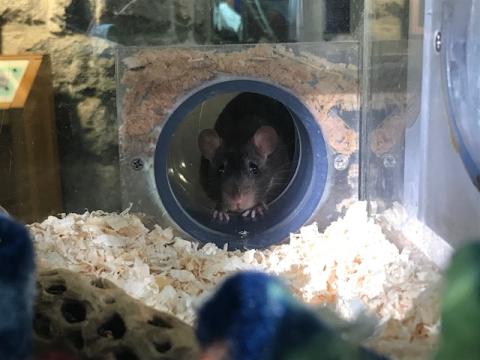
New at the Zoo: Norway Rats
Picture an intelligent mammal. One whose smarts are not only key to their survival but also, in certain situations, to that of humans. The Norway rat may not come first to mind, but its ability to memorize mazes, deftly run up and down walls and keen sense of smell make it a species worth...
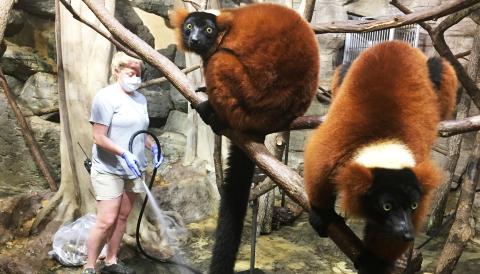
A Day in the Life of a Small Mammal House Keeper
Some of the Zoo’s most marvelous mammals are also the smallest—from alluring armadillos to endearing naked mole-rats. More than 35 species are on the move at the Small Mammal House, and it takes a team of creative keepers to care for them. Peek behind the scenes as keepers prepare puzzle feeders...
Western Lowland Gorilla at the Smithsonian’s National Zoo is Pregnant
For the first time in nine years, the Smithsonian’s National Zoo is making preparations for the highly anticipated birth of a critically endangered western lowland gorilla.
Smithsonian Conservation Biology Institute Seeking Names for Kiwi Chick
The Smithsonian Conservation Biology Institute in Front Royal, Virginia, and the Embassy of New Zealand in the United States are asking animal lovers to help name an endangered female brown kiwi chick.
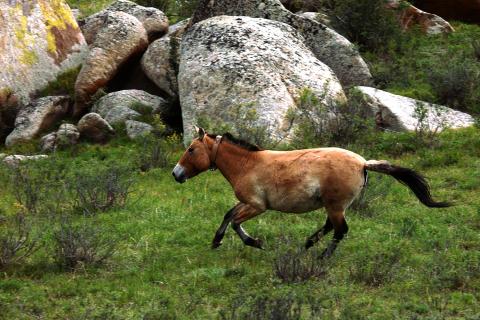
Tracking Takhi on the Steppe
In September, Conservation Ecology Center Postdoctoral Research Fellow John McEvoy traveled to Mongolia to track wolves and to study the movement behavior of reintroduced Przewalski’s horses—the last of the truly wild horse species. The following is an excerpt from his travel log. When I am not...
Smithsonian Scientists Help Pave Path To Large-Scale Coral Reef Restoration
As global warming, acidification and disease threaten a healthy future for the world’s coral reefs, conservationists in recent years have turned to the lab to study advanced reproductive methods, especially cryopreservation—or the freezing of coral eggs, sperm and other material—as a tool to produce...
ZooLights, Powered by Pepco, Begins Nov. 24 at the Smithsonian’s National Zoo
ZooLights—powered by Pepco—at the Smithsonian’s National Zoo is wilder than ever and a perfect holiday event for everyone in the family. Now in its 11th year, the annual free lights festival twinkles for 36 nights—from Nov. 24 through Jan. 1, 2018 (except Dec. 24, 25 and 31) from 5 p.m. to 9 p.m.
Prehensile-tailed Porcupine Born at the Smithsonian’s National Zoo
Small Mammal House keepers at the Smithsonian’s National Zoo welcomed a baby prehensile-tailed porcupine Oct 19.
White-cheeked Gibbon Euthanized at the Smithsonian’s National Zoo
Tuyen, a 10-year-old female white-cheeked gibbon at the Smithsonian’s National Zoo, was humanely euthanized Oct. 12, after suffering from progressive neurologic disease and acute seizures.
Male Sloth Bear Arrives at the Smithsonian’s National Zoo
The Smithsonian’s National Zoo recently welcomed a new sloth bear into its zoological family. Niko, a 2-year-old male, arrived Oct. 6 from NaturZoo Rheine in Germany and joins 3-year-old female sloth bear Remi at the Zoo’s Asia Trail exhibit.

Monkey Business: 2017 Gala
On Sept. 28, 450 party animals gathered for some Monkey Business—the Smithsonian's National Zoo and Conservation Biology Institute’s first-ever gala. Set in the tropical rainforest of Borneo, the evening honored Harrison Ford and Betty White with the James Smithson Bicentennial Medal for their many...

Black-Footed Ferret Update
SCBI is part of the Black-footed Ferret Recovery Program, which currently has a genomics workgroup that’s focused on better understanding the species genome and its role in breeding success.
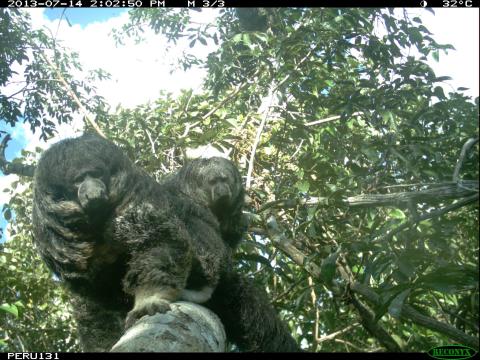
Taking a Swing at Connecting Habitat with Treetop Bridges
How do arboreal species in South America—such as the spider monkey and the tamandua—use tree canopies to move from place to place? Smithsonian Conservation Biology Institute biologist Tremaine Gregory scaled the forest to find out. As a member of the Center for Conservation and Sustainability team...

Where Do You Go, Brown Pelican?
For the first time ever, the Smithsonian Migratory Bird Center has teamed up with the Maryland Department of Natural Resources to track the migration of brown pelicans. In this Q&A below, research ecologist Autumn-Lynn Harrison talks about the migration.
Smithsonian Scientists Find Deadly Pathogen Not Present in Pet Salamanders in the United States
In 2016, the international import of 201 salamander species into the United States was restricted in an effort to prevent the newly discovered deadly salamander fungal disease, Batrachochytrium salamandrivorans (Bsal), from entering the country. In a new study, Smithsonian Conservation Biology...
Red Panda Cub Euthanized at the Smithsonian Conservation Biology Institute
We are sad to share that one of red panda Nutmeg’s cubs born June 14 at the Smithsonian Conservation Biology Institute in Front Royal, Virginia, was euthanized Oct. 4. Keepers rushed her to the veterinary hospital after they noticed that she was minimally responsive and had lost weight since her...

Bats in the Lab: Tracking the Path of White-Nose Syndrome
These bats have been dead for more than a century, but they are finding a second “life” as a research specimen. It may sound like a spooky science fiction story, but it is actually the work of scientists at the Smithsonian Conservation Biology Institute’s Center for Conservation Genomics and the...

A Day in the Life of an American Trail Keeper
A stroll down American Trail brings visitors face-to-face with swimming sea lions, busy beavers and resourceful ravens. What visitors may not see are the dedicated keepers working hard behind the scenes preparing diets, training animals and cleaning habitats. Get a glimpse into a day in the life of...
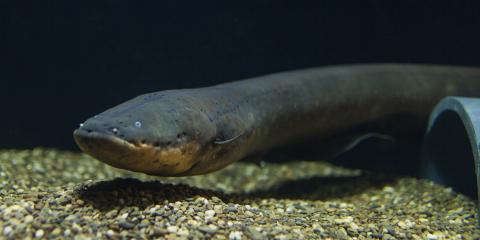
It’s Electric (Fishes)!
Video Visitors seeking to inject a jolt of fun into their trip to the Smithsonian’s National Zoo need look no further than Amazonia’s Electric Fishes Demonstration Lab! The exhibit, which opened Oct. 6, features six species of fish that emit powerful charges, pulses and waves in order to navigate...
New Electric Fishes Exhibit Opens at Smithsonian’s National Zoo
The Amazonia Exhibit at the Smithsonian’s National Zoo is buzzing with a current from a brand-new Electric Fishes Demonstration Lab, opening Oct. 6 at 10 a.m. The multisensory lab is home to a 5-foot-long electric eel, capable of generating up to 800 volts of electricity, four black ghost knifefish...
Smithsonian Conservation Biology Institute Releases Birds to the Wild
Two female Guam rails born at the Smithsonian Conservation Biology Institute in Front Royal, Virginia, were released to the wild in the Commonwealth of the Northern Mariana Islands Sept. 18. This month’s release marks the first time since 1985 that there are more Guam rails in the wild than in human...
Alpaca Dies at Smithsonian's National Zoo
The Smithsonian's National Zoo is mourning the loss of 12-year-old alpaca, Ziggy, who died Sept. 23.
